1.
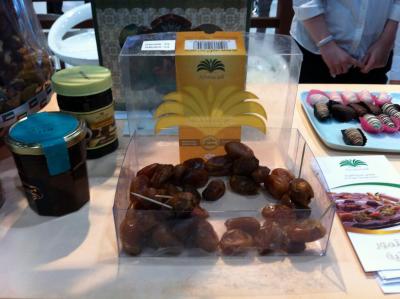
“That’s the best date I ever had,” I said. I was speaking to the young women with the latte skin and uncovered, long dark hair, but also to the serious-looking Emirati man who had wandered over because I was the only thing happening. Mid-week, midafternoon, the date festival was nearly deserted, save a few clusters of Indian men, single Western men in suits with briefcases, and a grumpy woman with big glasses. I suppose I was expecting this man, this representative of Al Foah, one of the largest date producers in the UAE, to be impressed somehow, or at least gratified, by my enthusiasm. I wasn’t exaggerating. The fruit had a thin, melting skin and a pillowy interior, the flavor rich, heady with sweetness and spice. (Hints of cardamom and apricot?) The serious man asked where I was from, and I proceeded to disappoint him with my ignorance about the production and sale of dates in the United States. Yes, I did think that dates had become more visible in grocery stores over the past five years, though I couldn’t say what varieties. Medjool? I did know that California was a hub, but, by then, I’d lost him.
I wandered on, though rows and rows of tender, yet hearty, fruit ranging from golden to olive to dark purple. Some were round and fat like big grapes; others the typical oval. The most mysterious fruits were the bicolored: lighter near the stem and darker at the bottom, as if they’d been dipped in chocolate. Dates don’t seem to have much perfume, but that might have been due to the general drenching of Abu Dhabi antiseptic wafting in from the main hall and, toward the back of the fluorescent-lit exhibition space, the insistent Abu Dhabi incense. I can’t name these smells, but I would recognize them anywhere.
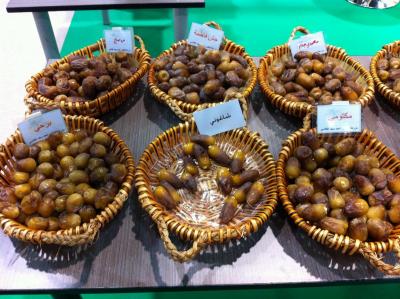
I’d come to the festival to experience the astounding variety, a fruit in all its forms, and hoping to see a cooking demo. Last winter, around this time, I’d slow-cooked a lamb leg with dates from a recipe in Claudia Roden’s sublime Arabesque, and the gamy, subtly sweet taste had stayed with me. Also, I missed fall New England apple celebrations and American farmers’ markets. So few things grow in the UAE, and here was a chance to taste and understand one of its indigenous things. The connection is sometimes facile, but food does join us to place, to localness, and I’d recently been having trouble settling in.
I had somehow thought that at the Emirates International Date Festival I would be sampling only Emirati dates, but I’d forgotten that this country is so young, and the native population so small, that a celebration of anything UAE-only would be rather limited. And, as closed to foreigners as Emirati society may be socially, this 41-year-old country is firmly connected through geography, religion, language, and culture to neighboring Arabic, Islamic countries.
The most impressive date presentation came from the Saudis, whose industry is one of the most robust in the world. Their geniality and enthusiasm were contagious, plus they offered the most extravagantly spiced coffee I’ve ever tasted, flavored with saffron, cardamom, ginger, cloves, and something called ajwain. A short, kind man in glasses and Arab dress encouraged me to sample dates gently softened in their own syrup (no sugar added!) and tossed with sesame and fennel seeds. Then he plucked a soft brown fruit from a basket and pulled it in half. He dipped one half into a dusky barley powder that cut the sweetness and added a pleasant, slightly sandy, texture. He ate the other half himself. He gave me an English-Arabic pamphlet about organic date farming in Saudi, along with a vacuum-packed sample to take home. At another table, a date researcher from King Saud University spent many minutes explaining the uses of date powder. One could make yellowy-beige, wafer-thin cookies (too sweet); or dip teabags of powder into warm milk; the combination was an excellent source of energy and nutrition for children, he said.
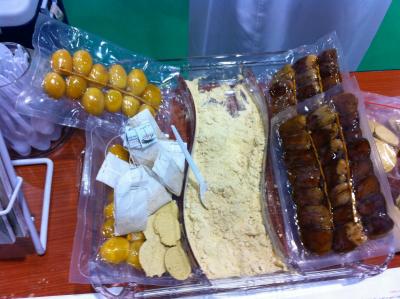
Dates are packed with vitamins (A, B6, K) and minerals (potassium, calcium, iron, magnesium) plus cancer-fighting antioxidants and cholesterol-fighting dietary fiber; various sources cite dates as beneficial for digestion, lactation, and respiration. Water-soluble sugars make dates the perfect food to break fasts, such as during Ramadan. Nomadic Bedouins lived largely on dates and camel milk when crossing long deserts.
I’d known dates were good for you, but I was surprised to learn of their religious significance. They’re mentioned repeatedly in the Quran, and Prophet Mohammed is said to have stood next to a date palm while saying his prayers, until one day, a woman offered him a seat, and the tree trunk cried from his absence. As a daily practice, the Prophet advised: Whoever has eaten seven date fruits of the high land in the morning, that day no poison or sorcery shall hurt him. And yet, this hefty symbolism was not a selling point among the festival vendors—not to someone who looked like me anyway. Instead they highlighted “healthier” varieties, meaning lower in sugar. Once the staple that kept Arabs alive, sugary dates are now one component of a calorific (meat-heavy) diet that, combined with a sedentary lifestyle that, has led to high rates of diabetes among Emirati populations.
From the Saudis’ elaborate samples to the three-foot tall Iraqi model of the Minaret of Samarra made entirely of dates…crossing the flat gray carpet, I walked past tents hosting date sellers from Sudan and Libya. All these forbidden, war-torn places representing their fruits.
2.
In 1888, Henry James published a long, slightly rambling, essay about his wealth of love for London. Despite its many flaws—including perpetual grayness from rain, fog, and soot—the bright spots trumped the gloomy. He recovered quickly from his unlovely entry into the city “through dusky, tortuous miles” that made him reflect: “It is a kind of humiliation in a great city not to know where you are going.” His destination was Morley’s Hotel in Trafalgar Square, which existed in his imagination as “only a vague ruddy spot in the general immensity…. The low black houses were as inanimate as so many rows of coal-scuttles, save where at frequent corners, from the gin-shop, there was a flare of light more brutal still than the darkness.” At last, James arrives and is relieved by the comfort of his lodgings. “Morley’s Hotel proved indeed to be a ruddy spot; brilliant, in my recollection, is the coffee-room fire, the hospitable mahogany, the sense that in the stupendous city this, at any rate, for the hour, was a shelter and point of view.”
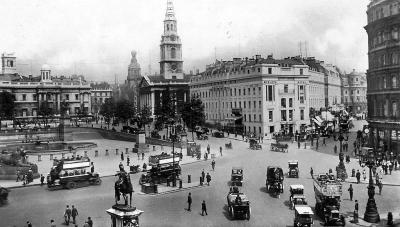
A snug spot with a fire and a bed swiftly becomes not just a way station, but a place from which the city can be seen.
Due to some unusual circumstances—travel for fun and work, family illness—I haven’t slept in the same room for more than six days in a row for the past two months. As October shaded into November, I was in a different bed every night for a week. Later in November we moved apartments, from the 17th floor to the 21st, which means our living-room view of the butter-colored mosque has been replaced by the neon signage of a pharmacy and its rooftop turbines and water towers. There’s blue sky on both sides, but you have to turn your head or walk a few steps to see.
In other words, my point of view has become unstable. What I see when I step out the door or stare into space is unreliable. Bedside lamps are not where I expect them to be; at night, instead of reading, I slip right under the covers and pull close the pillows. Waking in the morning, I don’t know where I am until my feet touch the floor. Cool tile? Turkish cotton? The woolen rug of a friends’ guest room? How far down is the street?
So many places in London remind James of literature, which makes the city feel even more welcoming because he has known it previously through stories. Dickens characters and lines from Sir Christopher Wren spark like matches in the gloaming. Despite the damp and the dark, James reports feeling generally warmly wrapped by London fog. Over time he sees a great deal of the city, but conquering it all is not a goal. In fact, the yet-unseen corners—and the promise of experiencing them some to-be-determined day—are a crucial part of what James appreciates about London. The long list of possibilities enlivens, even if plans are never executed.
I don’t know of any literary work written about or set in Abu Dhabi—though poetry is an important element of Arabic culture, and I’ve been told of an American Idol-like local TV show called Prince of Poets. It’s therefore not possible to warm up to the place or familiarize through reading—again, the country and city are too new. And despite the city’s limited landmass and scope, I’ve covered very little ground here. Part of this is due to it being a temporary home: at home, routine takes over. Excursions live, like James’s, largely in my mind. Still to visit are the wharfs where the dhows dock and freshly caught fish are grilled on the spot; the Grand Mosque whose brilliant white against the night sky I’ve seen several times from the highway and the vistas of nearby restaurants; Masdar City and its zero-carbon-footprint infrastructure; the Formula One racetrack on Yas Island. Further beyond, there are beautiful deserts and the oasis town of Al Ain. Then I think: Be careful, don’t let taking advantage weigh more heavily than it should.
3.
Dates palms grow, as they say, with their heads in the fire and feet in the water. Lots of sun and plenty of moisture for the roots. As greenery, they’re perfect for Gulf cities because their roots can withstand high salinity. In Abu Dhabi the sidewalks are patterned with squashed dark fruit—far preferable to the brown stains on the sidewalks of, say, New York.
Head in the fire and feet in the water: it’s a brave, tolerant existence, yet also finicky. Speaks to the art of building a scabrous trunk that both connects and withstands extremes. And the fruit of this tree such sustenance to travelers. Perhaps it was this notion as well as that of food as generally stabilizing when place is not that caused me to spend so many hours at the date festival. A few days earlier we’d celebrated Thanksgiving with forty other foreigners (Americans, Indians, Brazilians, Canadians). Roasting a turkey gave the semblance of normality, even if the eighty-five-degree day and Gulf views did not. Dates could be grounding, couldn’t they? Some specific lens through which to view the strangeness around me.
In a way, their sweetness was a salve, and so were the many small conversations that surrounded my sampling. Though the exhibition hall was sterile, my little tour was peaceful, as was the taxi ride back to the center of town, during which I saw that preparations for the weekend’s National Day celebration on December 2nd—when the UAE officially turned 41—were well underway.
Against the wall of a large villa, a trio of South Asian men propped a ladder to hang an enormous silky flag: a red rectangle on the left with stripes of white, green, and black. A well-watered grassy roundabout sported white and red flowers. In the evening, I went out for my standard walk around one of the city’s barricaded palaces and turned in awe at the neon flag lighting up a skyscraper. Another glowed with a huge “UAE” and, several stories underneath, “41.” The next night, when I swam at the outdoor pool at the nearby primary school, two workers were spray painting the flag onto the rock garden. No masks covered their mouths; one had tied a rag across his face. Two days later, street-level businesses had swept flags across their entire length of windows. SUVs painted with the faces of the royal family rolled by. I asked friends who had seen a couple of National Days if there was more to come. Oh yes, they said; much more.
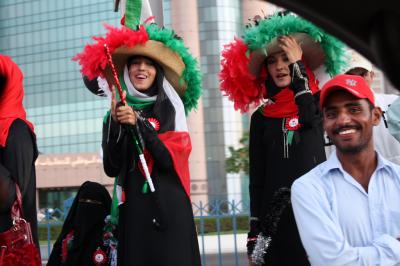
I was flying on National Day, so I missed the throngs on the Corniche, the spectacularly decorated cars, the Emirati women in abayahs who leapt into action spraying silly string at passersby. My suitcases in the cargo hold were, that day, packed with dates—khalas and khedris, fruits stuffed with almonds and pistachios and candied lemon and orange peels. They will keep a long time and give friends in the States a taste of my temporary home. And in the fridge in the new apartment, up three floors from where we started, are plump fresh dates from Saudi Arabia: olive-brown, gleaming with sugar. They’re too intense to allow living up to the Prophet’s suggestion of seven a day, but I do imagine—look forward to—a tasty and wholesome, though somewhat smaller, daily dose upon our return.
Jennifer Acker’s monthly essays “From the 17th Floor” are in conversation, directly or slant-wise, with contributor Martha Cooley’s Italy series “From the Stone House.” Together the two writers reflect on their recent physical and mental travels, on displacement and (re)settling, on explorations and discoveries that excite or discomfit, and, naturally, on literature and other arts.
Jennifer Acker is the founding editor of The Common.
Photos by Jennifer Acker and from Flickr Creative Commons



